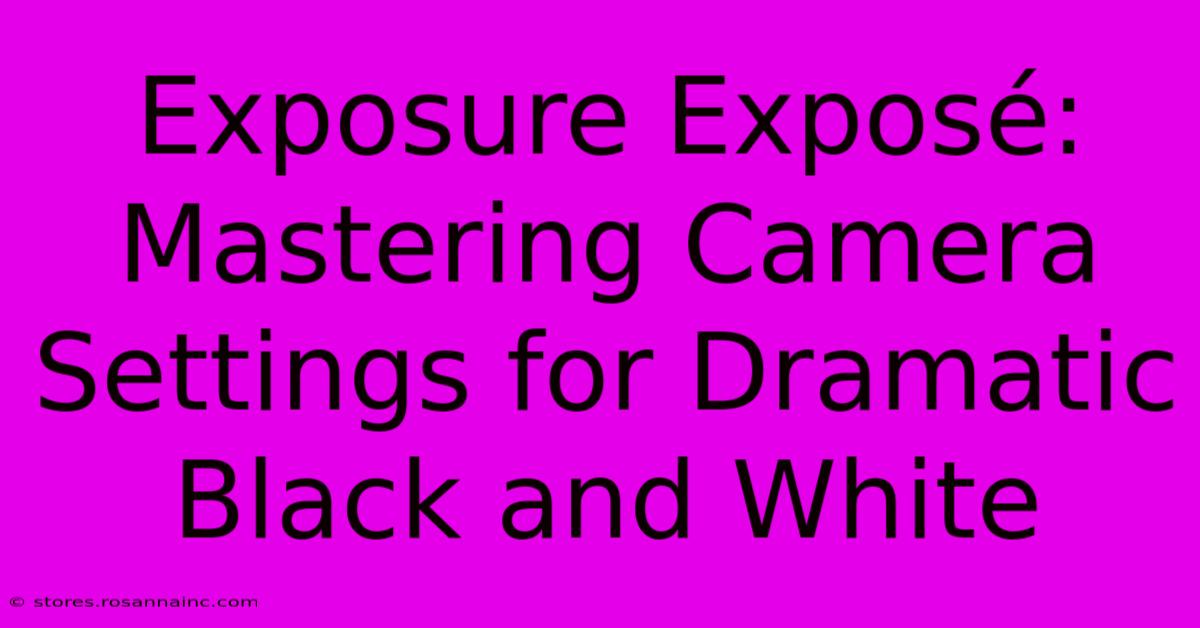Exposure Exposé: Mastering Camera Settings For Dramatic Black And White

Table of Contents
Exposure Exposé: Mastering Camera Settings for Dramatic Black and White
Black and white photography possesses a timeless elegance, capable of evoking powerful emotions and dramatic narratives. But achieving truly stunning monochrome images isn't just about converting a color photo; it's about mastering your camera settings to capture the essence of light and shadow that defines this art form. This comprehensive guide will illuminate the path to mastering exposure for breathtaking black and white photography.
Understanding Exposure's Role in Black and White
Before diving into specific settings, it's crucial to understand the fundamental relationship between exposure and black and white photography. Unlike color images where color can mask imperfections, black and white reveals every nuance of light and shadow, making precise exposure paramount. Overexposure can wash out detail, leading to a flat, lifeless image, while underexposure results in a muddy, dark image lacking in definition.
The Exposure Triangle: Aperture, Shutter Speed, and ISO
The exposure triangle – aperture, shutter speed, and ISO – forms the cornerstone of photographic exposure. Understanding how each element interacts is key to controlling your black and white images.
-
Aperture (f-stop): Controls the size of the lens opening, influencing depth of field. A wide aperture (e.g., f/1.4) creates a shallow depth of field, ideal for isolating subjects and creating a blurred background, while a narrow aperture (e.g., f/16) results in a deep depth of field, keeping both foreground and background in sharp focus. For dramatic black and white portraits, a shallow depth of field can be incredibly effective.
-
Shutter Speed: Determines how long the camera's sensor is exposed to light. Fast shutter speeds (e.g., 1/500s) freeze motion, perfect for capturing sharp action shots. Slow shutter speeds (e.g., 1/30s or slower) blur motion, creating a sense of movement and dynamism, especially useful for conveying a feeling of atmosphere or mood.
-
ISO: Measures the sensitivity of your camera's sensor to light. Low ISO (e.g., 100) produces cleaner images with less noise, ideal for well-lit conditions. High ISO (e.g., 3200 or higher) is necessary in low-light situations, but introduces more noise (grain). For dramatic black and white, embracing some grain can add to the overall texture and mood, though it's crucial to control the level of noise.
Mastering Exposure for Dramatic Effects
Now that we understand the basics, let's explore specific techniques for achieving dramatic black and white images:
1. Utilizing Light and Shadow
Black and white photography thrives on contrast. Seek out scenes with strong contrasts between light and shadow. Look for dramatic lighting conditions such as sunrise, sunset, or overcast days. Strategic positioning of your subject in relation to the light source can significantly impact the final image's drama.
2. Embrace High Contrast
High-contrast black and white images often possess a striking visual impact. This is achieved through careful consideration of exposure and lighting. Aim for a wide range of tones, from pure white to deep black, with a limited range of mid-tones. This can often be enhanced during post-processing.
3. The Importance of Metering
Accurate metering is essential. Use your camera's spot metering to measure the light in the most critical areas of your scene, ensuring that those areas are correctly exposed. Understanding how different metering modes (evaluative/matrix, center-weighted, spot) impact exposure is crucial for consistent results.
4. Post-Processing Enhancements
While achieving good exposure in-camera is critical, post-processing offers additional control. Software like Adobe Lightroom or Photoshop allows you to fine-tune contrast, tones, and shadows, further enhancing the dramatic impact of your black and white images. Experiment with different curves and contrast adjustments to achieve your desired aesthetic.
Conclusion: Unlocking the Power of Monochrome
Mastering exposure for dramatic black and white photography is a journey, not a destination. By understanding the interplay of aperture, shutter speed, and ISO, and by carefully considering lighting and post-processing techniques, you can unlock the full potential of monochrome and create truly breathtaking images that tell compelling stories. Embrace the challenge, experiment relentlessly, and discover your own unique style within the captivating world of black and white photography.

Thank you for visiting our website wich cover about Exposure Exposé: Mastering Camera Settings For Dramatic Black And White. We hope the information provided has been useful to you. Feel free to contact us if you have any questions or need further assistance. See you next time and dont miss to bookmark.
Featured Posts
-
Unveiling Carmen Marc Valvos Revolutionary Approach To Bridal Couture
Feb 04, 2025
-
Breathe A Sigh Of Relief Connect With A Pulmonologist Near You Today
Feb 04, 2025
-
Nail Innovation Builder Gel In A Bottle The Ultimate Game Changer
Feb 04, 2025
-
Unleashing The Cta The Key To Seamless Desktop User Experiences
Feb 04, 2025
-
Unleash Your Inner Riley Exclusive Preview Of Inside Out 2 Poster
Feb 04, 2025
